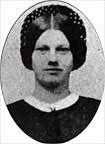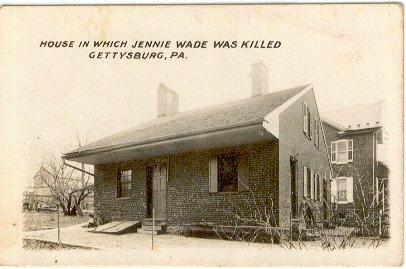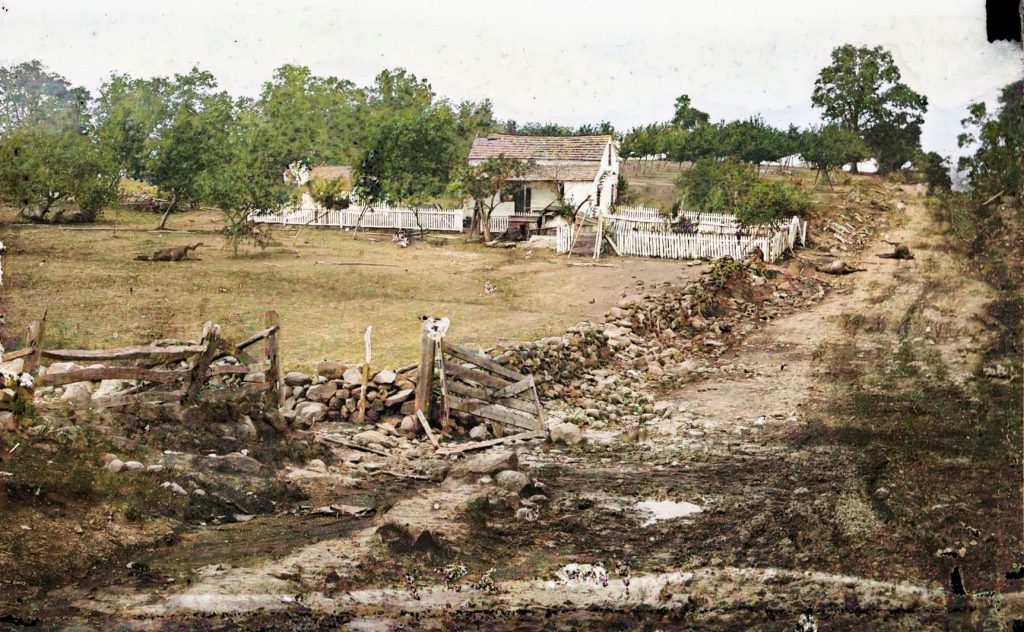Historians seem to agree that during the epic clash between two 100,000-man armies in southern Pennsylvania, only one civilian was killed. Twenty-year-old Mary Virginia Wade (“Ginnie” to family and friends; aka “Jennie”) was baking bread in her kitchen on the southern end of the city when a bullet penetrated her door hit her in the side and heart killing her instantly. The irony is that she was killed by that stray bullet on Day 3 at a time when there was no actual fighting going on in that area.


At the time of the battle, Gettysburg had a population of about 2400. In the actual area of the battle itself, there were also about a dozen farmsteads that played various roles over the course of the battle. The farmers and their families on the outlying farmsteads would most likely have evacuated themselves into the city for protection. They would have become aware that Lee’s army was in the area when small groups of scavengers appeared searching for livestock and fresh produce to feed the troops. Later that same morning, BG Buford led his Union Cavalry Brigade up the Emmittsburg Rd. Their appearance would have brought some comfort to the city’s inhabitants. But that was short-lived as they deployed for battle just outside the city’s western edge.
At the sound of the cannons that initiated the Day 1 ambush, most of the city’s resident, especially those on the western side of the city, descended into their cellars for protection. Since the main defensive Union line was just outside the city, it is hard to believe that none of the artillery shells that the Confederates threw at the Union line would not have found their way into the city’s edge. This is compounded when you factor in that they were likely using the same shells with the faulty fuses that caused such a problem on Day 3. And yet no civilian casualties were reported. By late afternoon, with the arrival of two divisions of LTG Ewell’s Corps commanded by MG Rodes and MG Early, the fighting completely surrounded the city with Rodes to the north and Early in the east.
All of the senior leaders of both armies independently agreed that the city itself held no strategic or tactical value. The city was never directly attacked nor bombarded. The greatest danger to its citizens came at the end of the fighting on Day 1 when the Union troops to the north of the city broke under attacks by Rode’s and Early’s divisions. A few thousand of them fell back into the city for protection. They were pursued by a few hundred Rebels, but the Union soldiers were intent only on moving through the city to assemble at the Cemetery. The pursuit by the Rebels was slowed by a team of sharpshooters (snipers) who had been sent to find vantage points to guard against any Confederate units that might enter the city. That was the only fighting that took place inside the city and that lasted only a few hours as the sun set.
==========================================================
After the Battle of Gettysburg over 3000 bodies of horses were burned causing an incredible stench for days following the battle. Three thousand seems a bit excessive, but the reference was contemporary so has to be given some level of credence.
How might 3000 horses have died there? My guess is that the majority belonged to the Union Army. Much more so than the Rebels, their horses would have been at risk. The Union forces that engaged the rebels on Day 1 were Cavalry; some 3500 of them. They sprung the ambush as dismounted infantry, so most of their horses would have been somewhat to the rear but still accessible to allow the soldiers to re-mount and reposition themselves. By the end of the day, there would have been a large number of rider-less horses, but these valuable and valued animals would have been led off the battlefield by surviving, withdrawing soldiers. At worst, they would have been loosed and captured by the rebels; surely few perished in the fighting. Some would have been caught in the crossfire of the shifting battle but no so many as anywhere near 3000 could be accounted for.
In their combined armies Lee and Meade had about 200,000 troops. Within the combat elements any horses would have belonged to the senior officers. At most, there would have been 1 horse for perhaps 50-70 infantrymen. Although mid-level officers might have ridden to the battle, once they reached the front most would have dismounted and joined their men as infantry.
On Day 2 with the rebel flanking attacks up the slopes of the hilltop Union defensive positions, few horses would have been ridden into battle. The largest group of horses at risk that day were those drawing the artillery that supported MG Sickles’ division when it moved forward of the defensive perimeter up to the Peach Orchard. These artillerymen were placed in the center of Sickles’ line without infantry support to guard them. They were attacked directly by rebel infantry and took heavy casualties. Undoubtedly, some horses would have been killed in those attacks but there were at most a few dozen horses drawing those cannons.

I’d suggest that they majority of equine casualties must have occurred on Day 3 and almost solely among the Union forces. Lee had massed his 120+ cannons on the top of Seminary Ridge and he unleashed the largest artillery barrage ever witnessed in the Western Hemisphere. Dozens of cannons fired off 3-5 shots per minute for one hour. 120 x 3 X 60 = 21-23,000 cannon balls aimed at a small area of the Union lines.
The Union defensive perimeter was only about 3 miles long in an inverted-“J” formation. On the reverse slopes of the hills, the entire logistics train was concentrated into a small area. Because of a problem with the fuses on the rebel cannon balls, the majority of them sailed over their intended targets and into this rear area. It is highly likely that horses were among the main casualties; as well as a fair number of non-combatant troops.
Lee had almost his entire logistics wagon train encamped behind Seminary Ridge out of sight and out of range of Union artillery. Few, if any, of his horses would have been killed over the 3-day battle.
The 3000 animals killed must have been but a small fraction of those present on the battlefield and its environs. Supplies, kit and ammunition for 100,000 soldiers must have filled hundreds of wagons, others were ambulances to evacuate the wounded; still others pulled the cannons and their ammunition caissons. Lee’s retreat back to Virginia is said to have had wagon loads of wounded that stretched for seemingly endless miles.
